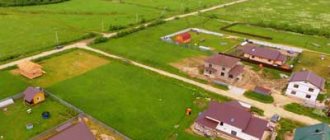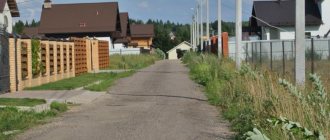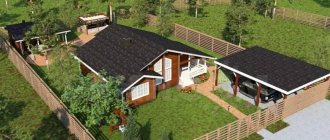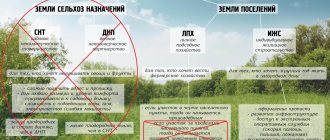One of the most popular types of land use is vegetable gardening.
Plots for this purpose can be allocated both from the lands of settlements and agricultural lands. In most cases, the users of such plots are residents of urban areas and large settlements who do not have the opportunity to grow vegetables on plots located next to their homes.
In legal acts and documents establishing rights to a land plot, such a VRI is designated:
- garden plot of land;
- plot for gardening;
- for gardening.
Permitted activities
According to land legislation, the direct purpose of an allotment that has a VRI “Vegetable gardening” is:
- growing vegetable and fruit and berry products for own needs;
- people's recreation;
- construction of outbuildings for the purpose of use - storage of equipment, as well as crops collected from the site.
Conducting economic activities on lands allocated for gardening can be carried out individually , as well as through the creation of partnerships and other associations of land owners.
Within the framework of SNT
Membership in an association created by citizens for the purpose of joint ownership and use of garden plots and other property in their common ownership has the following advantages :
- Assistance in connecting the necessary communications - electrical networks, gas and water supply networks, sewerage.
- Solving the issue of solid waste disposal by concluding an agreement with a regional waste management operator.
- Ensuring fire safety of the territory.
- Land improvement and protection.
- Assistance to citizens in the development of allocated land plots.
- Interaction with authorities and regulatory structures.
- Legal assistance to protect the legitimate interests and rights of citizens.
On lands allocated for vegetable gardens, it is prohibited :
- construction of a residential building;
- registration at the place of residence;
- carrying out activities that disturb the fertile layer of the earth.
If a plot located on agricultural land is not used in accordance with its purpose, it may be alienated from the owner in court.
Owners of a plot located on the territory of a gardening partnership do not have the right to :
- demand the allocation in kind of your part of the land from the volume of public real estate;
- alienate one's land share to provide it to another person without transferring ownership rights to it.
The legislation does not require registration of outbuildings erected on lands with the VRI “Vegetable gardening”.
In what cases should the type of permitted use of a land plot be changed and how to do it?
Often, land owners have confusion about what type of permitted use (PUR) their plot belongs to, what activities can be carried out on it and which cannot be carried out, and in what cases the PUR should be changed. The questions are extremely serious, since VRI is the main factor in determining the cadastral value of a land plot. In addition, for using a land plot not for its intended purpose, an administrative penalty in the form of a fine is imposed.
In this material we will explain in detail what types of permitted use of land there are, what you should consider if you are planning to build a house on the site or raise farm animals, and how you can change the VRI, if this is still necessary.
Classifier of types of permitted use
Permitted use of a land plot is a characteristic that answers the question of how exactly the land plot can be used, in particular, what can be built on it. You can use a plot of land, even if it is owned, only in accordance with its belonging to a certain category of land and the type of permitted use.
The land on the territory of municipalities is divided into territorial zones. A territorial zone is an area that has boundaries and for which certain urban planning regulations have been established. For each such territorial zone, local authorities establish: types of permitted use of land plots, what real estate objects can be built, their height parameters, etc.
IMPORTANT! Local authorities determine the types of permitted uses for each territorial zone based on the historical conditions of use of the territory, as well as based on the results of public hearings. Urban planning zoning documents regulate which VRIs can be chosen by land owners independently, which ones can be chosen after obtaining permission, and for which types of activities the plots cannot be used. These distinctions are established to ensure the protection of the population and ensure comfortable living conditions.
There is a Classifier of types of permitted use, approved by order of Rosreestr dated November 10, 2021 P/0412. Based on this classifier, municipalities establish for each territorial zone the main types of permitted use, auxiliary and conditionally permitted .
The classifier contains 13 VRI:
- Agricultural use (crop growing, horticulture, beekeeping, fish farming, etc.);
- Residential development (for individual housing construction, for running personal subsidiary plots, multi-storey residential development, etc.);
- Public use of capital construction projects (health care, social services, education, etc.)
- Entrepreneurship (trade facilities, markets, shops, etc.)
- Leisure (recreation) (sports, tourist services, hunting and fishing, etc.)
- Manufacturing activities (heavy industry, energy, communications, etc.)
- Transport (railway transport, road layout, air transport, etc.)
- Ensuring defense and security (providing for the armed forces, protecting the state border of the Russian Federation, etc.)
- Activities for special protection and study of nature (protection of natural areas, sanatorium activities, etc.)
- Use of forests (timber harvesting, forest plantations, etc.)
- Water bodies (hydraulic structures, etc.)
- Land plots (territories) for public use (road network, landscaping, etc.)
- General purpose land plots (vegetable gardening, gardening).
The main types of permitted use characterize the main type of activity for the purposes of which the land plot is acquired and used (for example, residential development or agricultural use)
Conditionally permitted uses of land plots are used when it is necessary to expand the use of land - for example, if you plan to build a gas station on a site that is intended for the construction of a store. The procedure for obtaining permission for a conditionally permitted VRI is established by the Town Planning Code of the Russian Federation.
Auxiliary VRI are used to clarify the intended purpose of the site. For example, such an additional type of permitted use may be needed if the owner wants to build a fence, garage, or outbuilding on the site.
How to find out what VRI your land plot has
Information about the type of permitted use of the land plot is contained in the Unified State Register of Real Estate. This is an additional characteristic of the site.
You can clarify the type of permitted use of a land plot by ordering an extract from the Unified State Register of Real Estate (USRN) on the main characteristics of the property. This can be done using electronic services on the Rosreestr website, in the offices of the MFC, on the State Services portal, as well as on the website of the subordinate Federal State Budgetary Institution FKP Rosreestr.
In this case, the information will be indicated in the “Types of Permitted Use” section.
You can also use the “Public Cadastral Map” service. To do this, you need to know the address of the site or its cadastral number.
Which VRI is suitable for construction of an individual residential building on a site
In this case, the following types of permitted use are suitable:
- 1 - “For individual residential construction.” On such plots it is also permitted to build garages and auxiliary buildings, and to grow agricultural crops;
- 2 - “For running a personal subsidiary plot.” Here you can not only build a residential or garden house, but also produce agricultural products and raise farm animals;
- 2 - “Gardening”. Such areas are intended for recreation and (or) cultivation of agricultural crops by citizens for their own needs. You can also build houses here - residential and garden.
NOTE! If your site has the main VRI 13.1 “Vegetable gardening”, then the construction of a residential and garden house on it is prohibited. Only the construction of outbuildings for storing equipment and agricultural crops is allowed. This type should not be confused with 13.2 “Gardening”, where the construction of a residential building is allowed.
The situation is similar with VRI 1.16 “ Conducting personal subsidiary farming on field plots,” where only the production of agricultural products is allowed without the right to construct capital construction projects. At the same time, VRI 2.2 “For running a personal subsidiary plot” allows such construction.
IMPORTANT! If the type of permitted use of your land plot does not correspond to those indicated above, then in order to build a residential or garden house on it, you will need to change the VRI.
Construction on land with this status
Before the entry into force of the new Federal Law “On Gardening, Vegetable Farming and Summer Housekeeping”, it is allowed to place on garden plots:
- non-permanent residential buildings;
- outbuildings to support agricultural activities.
It is worth noting that residential buildings can only be built on the lands of populated areas .
Read more about construction options on lands for “Vegetable gardening” in a separate article.
Legislation
From 2021, it is legally permitted to build only buildings that do not have a foundation . Since these buildings are easily dismountable, their registration as real estate is not provided.
Law 217-FZ, which replaces the current 66-FZ, is intended to streamline the use of garden land plots and eliminate existing legal conflicts that complicate an unambiguous interpretation of the legislation.
If a permanent residential building has been erected on your plot that has a VRI “Vegetable Gardening”, to legitimize it, go through the procedure of changing the VRI of the land.
Vegetable garden without documents
The essence of the problem is as follows. In our country there is a huge number of land plots, which during the Soviet Union were used by factories, mills and other various enterprises and organizations for their employees. For some of these areas there are either no documents at all, or the yellowed pieces of paper are long ago and hopelessly outdated.
Many enterprises that allocated acres to their employees for vegetable gardens have long ceased to exist. Their archives were also destroyed.
Of course, no one is expelling citizens from such plots, but people cannot do anything with such acres - neither sell, nor donate, nor bequeath. Moreover, if, according to urban planning plans, hundreds of acres are transferred to the local authorities for new facilities, they buy the land only from those who have legal acres.
The lack of required documents for the owners of such acres constantly gives rise to problems. The main thing is how to register ownership of such a plot.
Our story began in the Leningrad region, where a certain citizen received in 1991 from the executive committee of the village council of people's deputies of the Priozersky district a plot of 6 acres for a vegetable garden. The land was provided without the right to erect any buildings.
In 2015, the owner of six acres died. But a year before this, the gardener bequeathed all his property to his daughter. When the heiress came to the notary, he refused to formalize inheritance rights to the land. The reason is the lack of title documents. Then the heiress went to court. She filed a lawsuit against the administration of the Priozersky district municipality for recognition of ownership of the land plot “by inheritance.”
But the heiress was unlucky in court. The Priozersky City Court of the Leningrad Region rejected her claim. The woman disputed the refusal. But she was unlucky again - the Leningrad Regional Court agreed with the first instance.
The local courts unanimously decided that the plot was provided to the plaintiff's father for temporary use, and the right of permanent perpetual use or lifelong inheritable possession did not arise for the testator. The courts concluded that there are no grounds for recognizing a citizen’s right of ownership by inheritance to the disputed land plot.
In the absence of information about the right to a plot, it is considered to be provided on the basis of ownership
The heiress had to move on. And she appealed to the Supreme Court. There they carefully studied the materials of the dispute and agreed with the applicant’s arguments.
The Supreme Court of the Russian Federation noted that the decision of the executive committee to provide the site does not contain any information about the type of right under which it was granted. At the same time, paragraph 1 of clause 9.1 of Article 3 of the law on the entry into force of the Land Code says the following: if the land was provided before October 25, 2001 for vegetable gardening or horticulture on the right of lifelong inheritable possession or permanent (perpetual) use, you can register ownership of it .
The exception is cases when, in accordance with federal law, such a plot cannot be provided as private property. This means, the Supreme Court noted, in order to properly resolve the dispute, the local court should have established whether or not there were restrictions provided for by federal law for the provision of land into private ownership.
But the city court did not ask this question. And since this was not done, the Judicial Collegium for Civil Cases of the Supreme Court of the Russian Federation overturned all decisions of the lower courts. The Supreme Court sent the case about the dispute over six hundred square meters for a new trial to the court of first instance.
Experts believe that we have many decisions similar to those adopted by the Priozersk City Court. Therefore, the Supreme Court's clarification is especially important. After all, with such decisions, local courts violate the substantive law and come to the erroneous conclusion: since the plot was in temporary use, the testator did not have ownership rights to it.
The Supreme Court especially for such cases emphasized: in the absence of information about the right under which a citizen owns a plot and a ban on granting it to private ownership, the disputed land plot should be considered provided to the person on the right of ownership.
Features of plots allocated from the category of lands of settlements
The legislation, which introduces into practice an explanation of the term “garden plot” and outlines the legal framework for its use, also contains instructions on the provisions of the city regulations , which are a direct restriction on construction work on these lands.
The existing law enforcement practice refers the land user to the PZZ approved by local self-government bodies at various levels. On the basis of these documents, in practice, construction of objects not prohibited by PZZ is carried out on garden lands.
The city regulations in force in the development area regulate construction and provide additional opportunities for construction work.
Thus, acts of some regions allow the placement of auxiliary objects not directly prohibited by law on lands for gardening:
- bathhouse
- garage
- mini-parking for your own car
The explanation in the law for the term land object with VRI “Vegetable gardening” also serves as a definition of the presence or absence of the possibility of constructing non-permanent residential and temporary ancillary facilities on the land.
A permit or a ban is issued on the basis of the existing division of the land territory into zones. Upcoming changes in legislation will introduce a total ban on the construction of housing on garden lands.











